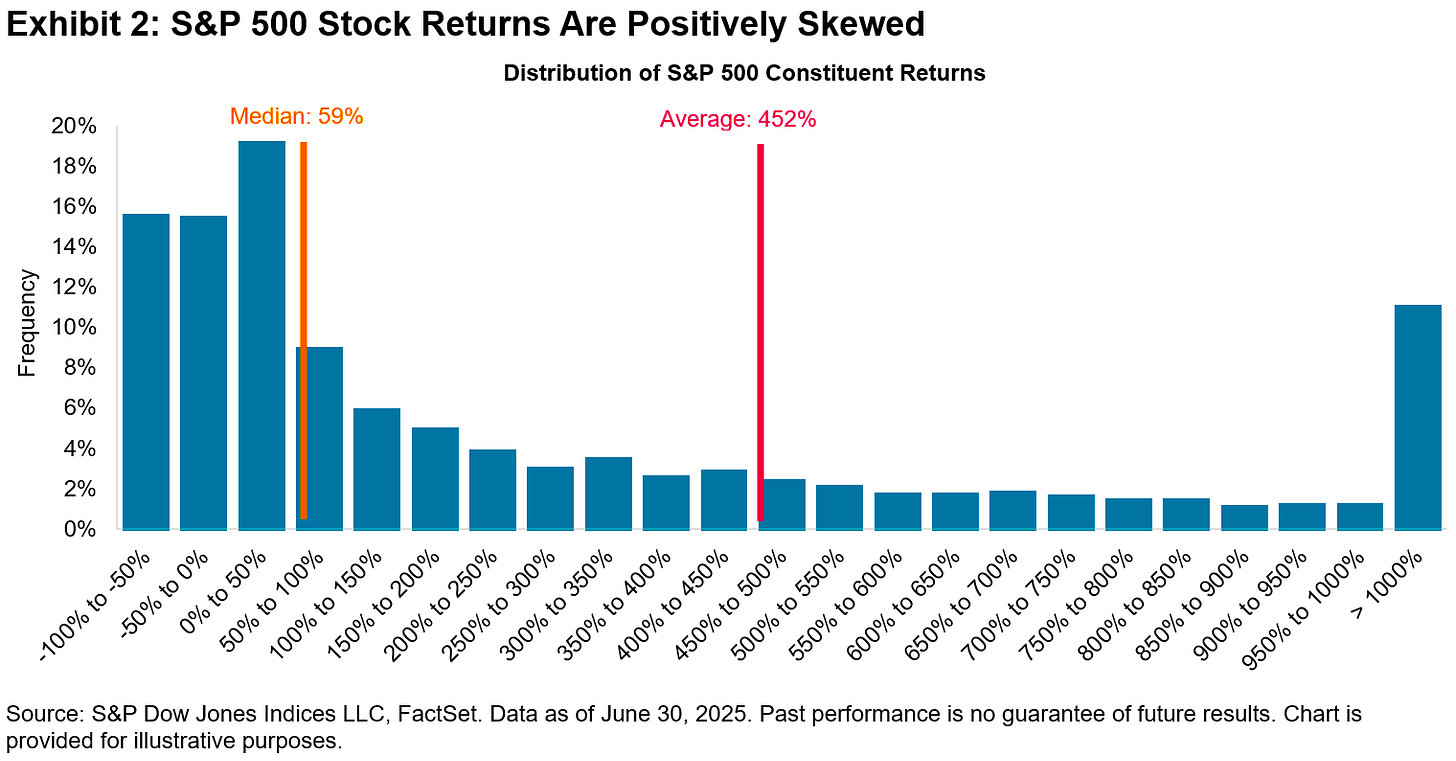How do I think of today’s AI craze relative to past bubbles? 🫧🤖🚂🚗
Plus a charted review of the macro crosscurrents 🔀
📉The stock market fell last week, with the S&P 500 declining 1.6% to close at 6,623.43. The index is now down 3.9% from its Oct. 29 closing high of 6,890.89 and up 12.6% year-to-date. For more, check out the Stock Market tab at TKer. »
-
Will AI prove to be a bubble like what we experienced 25 years ago with the Internet boom?
Financial author Phil Rosen asked me for my thoughts on his show, “Full Signal.”
I think we should be both optimistic about the future, but also concerned about how things will unfold as we get there.
Whenever you have a game-changing breakthrough in innovation and technology, the excitement over the opportunity will inevitably lead to an overshoot in investment.
As I’ve written for the past two years, I think the potential for AI is massive. Across industries, companies have identified ways to use AI to do things more quickly and often more cheaply. This is the fundamental offering of productivity-enhancing technology: It saves you time and/or money.
People will pay to save time and money. And economics 101 teaches us that where there’s demand, there will be supply.
And that supply is coming with eye-popping amounts of investment, with mountains of cash financing capital expenditures, tons of venture capital flowing into new startups, and lots of savings getting reallocated into the publicly traded companies advancing AI technology.
A lot of those investments will prove lucrative. And a lot will flop.
This behavior is not new. It echoes past technological breakthroughs.
At Berkshire Hathaway’s 2021 annual meeting, Warren Buffett made this observation about the automobile boom of the early 1900s.
“It transformed the country,” he said. “There were at least 2,000 companies that entered the auto business because it clearly had this incredible future. And of course, you remember that in 2009, there were three left.”

Another example of a formerly white-hot industry is rail transport.
We often talk about how big the tech sector has become as a share of the stock market, drawing parallels to the dot-com bubble. But it doesn’t compare to rail a hundred years ago.
“Markets at the beginning of the 20th century were dominated by railroads, which accounted for 63% of US stock market value and almost 50% in the UK,“ UBS analysts wrote.

I don’t know too much about the 1800s. However, I understand that there were hundreds of railroad companies financed by those eager to cash in on the buildout of the country’s logistics infrastructure. And the industry’s rise also came with financial crises.
Railroads and automobiles continue to deliver on the promises of saving us time and money. But we wouldn’t have what we have today without overinvestment and a couple of financial blowups.
The big picture 🖼️
As excited as we might be about the stock market returns we’ve realized in the AI boom, it would be a mistake to get complacent.
The emergence of new technology usually comes with volatility in the markets and the economy.
But also, market crashes aren’t guaranteed. And even if we do get what’s deemed an AI-bubble crash, it’ll be close to impossible to time it.
Keep in mind that former Fed Chair Alan Greenspan gave his “irrational exuberance” speech four years before the dot-com bubble peaked. And importantly, the S&P 500 at the post-bubble low was actually higher than where it was when Greenspan gave that speech.
Assuming we do experience a correction related to AI, there’s no way to know the depth and duration before it happens. Maybe it already happened. Maybe there will be multiple bumps in the market’s move higher.
For most investors, the best move is to stay invested through the ups and downs, which can sometimes take years to recover from.
If you’re unable to put in the time and you’re unwilling to stomach the volatility, the stock market may not be for you.
-
Related from TKer:
The next couple of years for the job market could be tough 🫤
Fed Chair Powell’s remark about the stock market is not breaking news 🗞️
Smart people agree that the best investing wisdom shares a common theme 🧐
Watch and Listen! 📺🎧
I was on Full Signal with Phil Rosen. We talked about stock market valuations, AI, the K-shaped economy, economic narrative violations, and more! Watch on YouTube or listen on Spotify!
Review of the macro crosscurrents 🔀
There were several notable data points and macroeconomic developments since our last review:
🚨Despite the government reopening after a lengthy shutdown, economic data from federal agencies continues to be delayed. Until that data is released on its normal, timely schedule, we’ll be leaning more on private sources of data. You’ll also notice some gaps in the FRED charts reflecting the shutdown period.
👎 Job growth remains negative. According to payroll processor ADP, private U.S. employers shed 2,500 jobs in the four weeks ending Nov. 1.

For more on what the private data providers are saying about jobs, read: The unofficial jobs data is unambiguously discouraging 💼
💼 New unemployment claims tick lower, but total ongoing claims remain elevated. Initial claims for unemployment benefits declined to 220,000 during the week ending Nov. 15, down from 228,000 the week prior. This metric remains at levels historically associated with economic growth.

Insured unemployment, which captures those who continue to claim unemployment benefits, rose to 1.974 million during the week ending Nov. 8. This metric is near its highest level since November 2021.

Low initial claims confirm that layoff activity remains low. Elevated continued claims confirm hiring activity is weakening. This dynamic warrants close attention, as it reflects a deteriorating labor market.
For more context, read: The hiring situation 🧩 and The labor market is cooling 💼
💳 Card spending data is holding up. From BofA: “Total card spending per HH was up 1.6% y/y in the week ending Nov 15, according to BAC aggregated credit & debit card data. The drop in y/y airline & lodging spending growth since last week is likely due to flight cuts caused by the Govt. shutdown. As we approach the holiday season, spending per HH on holiday items is tracking significantly ahead of 2023 and 2024 levels.”
From JPMorgan: “As of 14 Nov 2025, our Chase Consumer Card spending data (unadjusted) was 3.9% above the same day last year. Based on the Chase Consumer Card data through 14 Nov 2025, our estimate of the US Census September control measure of retail sales m/m is 0.12%.”
For more on economic activity, read: 9 once-hot economic charts that cooled 📉 and We’re at an economic tipping point ⚖️
👎 Consumer vibes deteriorate. From the University of Michigan’s November Surveys of Consumers: “Consumers remain frustrated about the persistence of high prices and weakening incomes. This month, current personal finances and buying conditions for durables both plunged more than 10%, whereas expectations for the future improved modestly. By the end of the month, sentiment for consumers with the largest stock holdings lost the gains seen at the preliminary reading. This group’s sentiment dropped about 2 index points from October, likely a consequence of the stock market declines seen over the past two weeks.”

“Consumers, especially younger ones, perceive rising risks of job loss,” the survey found.

Consumer sentiment readings have lagged resilient consumer spending data. For more on this contradiction, read: What consumers do > what consumers say 🙊 and We’re taking that vacation whether we like it or not 🛫
⛽️ Gas prices tick higher. From AAA: “As drivers prepare to hit the road for Thanksgiving in record numbers, gas prices are relatively steady compared to last week. The national average for a gallon of regular went up by a couple of cents to $3.10. Despite the burst of gasoline demand that will occur during Thanksgiving week, overall demand is low this time of year which helps keep pump prices down. The national average has seen few fluctuations in 2025 thanks to low crude oil prices and no major storms affecting Gulf Coast refineries.”

For more on energy prices, read: Higher oil prices meant something different in the past 🛢️
🏘️ Home sales tick higher. Sales of previously owned homes increased by 1.2% in October to an annualized rate of 4.10 million units. From NAR chief economist Lawrence Yun: “Home sales increased in October even with the government shutdown due to homebuyers taking advantage of lower mortgage rates. First-time homebuyers are facing headwinds in the Northeast due to a lack of supply and in the West because of high home prices. First-time buyers fared better in the Midwest because of the plentiful supply of affordable houses and in the South because there is sufficient inventory.”
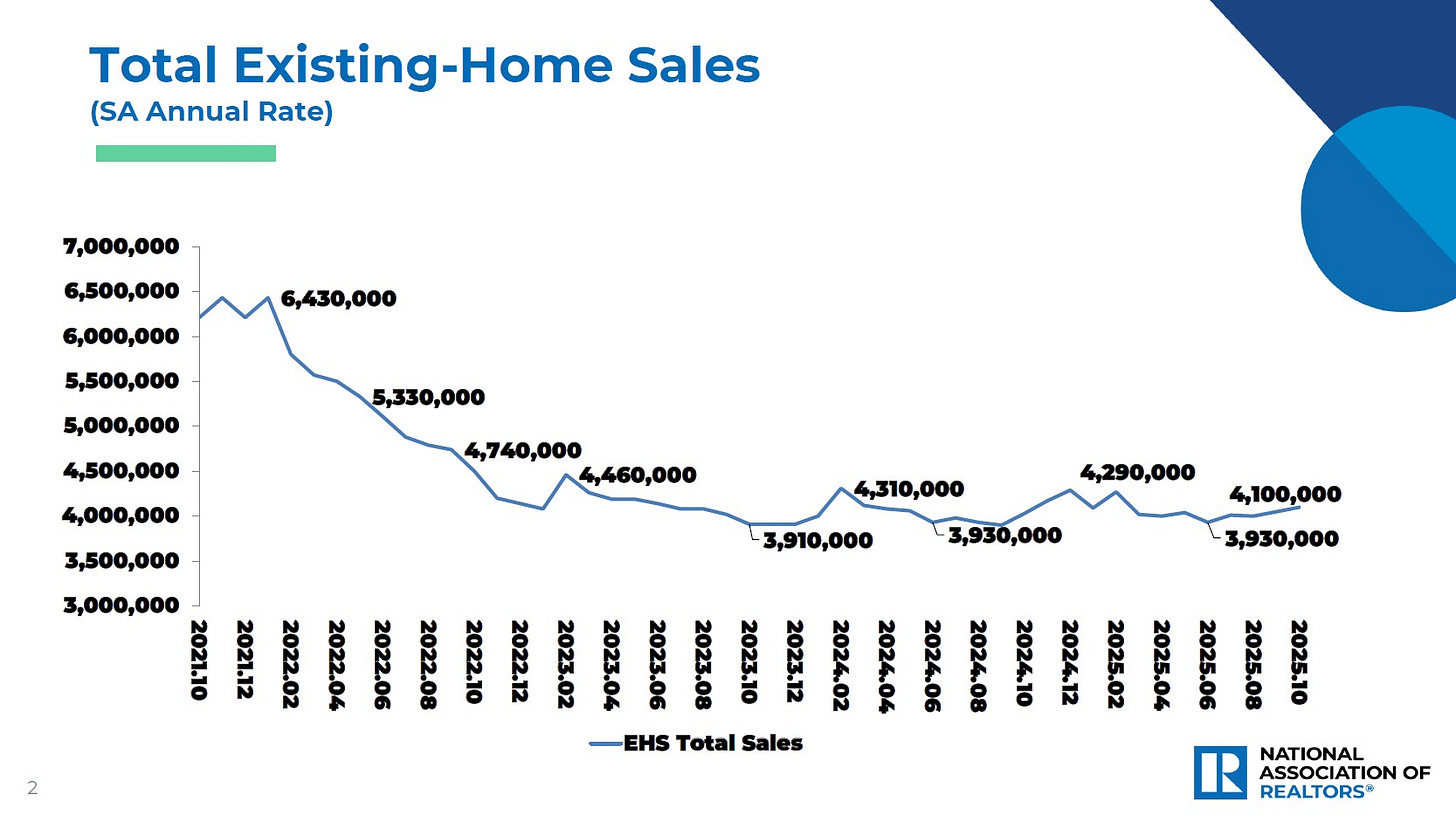
October’s prices for previously owned homes rose month over month and year over year. From the NAR: “The median existing-home sales price for all housing types in October was $415,200, up 2.1% from one year ago ($406,800) – the 28th consecutive month of year-over-year price increases.”

For more on housing, read: The U.S. housing market has gone cold 🥶
🏠 Homebuilder sentiment improves. From the NAHB: “We continue to see demand-side weakness as a softening labor market and stretched consumer finances are contributing to a difficult sales environment. After a decline for single-family housing starts in 2025, NAHB is forecasting a slight gain in 2026 as builders continue to report future sales conditions in marginally positive territory.”

🏠 Mortgage rates tick higher. According to Freddie Mac, the average 30-year fixed-rate mortgage rose to 6.26%, up from 6.24% last week: “Mortgage rates have been shifting within a narrow ten-basis point range over the last month. This rate stability is a positive sign for both buyers and sellers, as it helps provide greater certainty in the housing markets.”

As of the summer, there were 147.9 million housing units in the U.S., of which 86.1 million were owner-occupied and about 39% were mortgage-free. Of those carrying mortgage debt, almost all have fixed-rate mortgages, and most of those mortgages have rates that were locked in before rates surged from 2021 lows. All of this is to say: Most homeowners are not particularly sensitive to the small weekly movements in home prices or mortgage rates.
For more on mortgages and home prices, read: Why home prices and rents are creating all sorts of confusion about inflation 😖
😬 This is the stuff pros are worried about. From BofA’s November Global Fund Manager Survey: “November saw an uptick of concerns around an AI bubble. …asked about the biggest ‘tail risk’ for the economy and the markets, 45% of FMS investors said ‘AI bubble’ (up from 33% last month).”
For more on risks, read: Three observations about uncertainty in the markets 😟 and Two times when uncertainty seemed low and confidence was high 🌈
Below are data that were released by Federal agencies last week. The numbers are a bit stale, but worth seeing.
📈 Job creation in September was positive, but unemployment rose. According to the BLS’s Employment Situation report released Friday, U.S. employers added just 119,000 jobs in September. Notably, the August tally was revised down to a loss of 4,000 jobs. It’s a reminder that we’re at an economic tipping point.
The Labor Department said it won’t have an October jobs report, so the next survey will be published for November’s numbers.

Total payroll employment was at a record 159.6 million jobs in September, up 7.3 million from the prepandemic high..
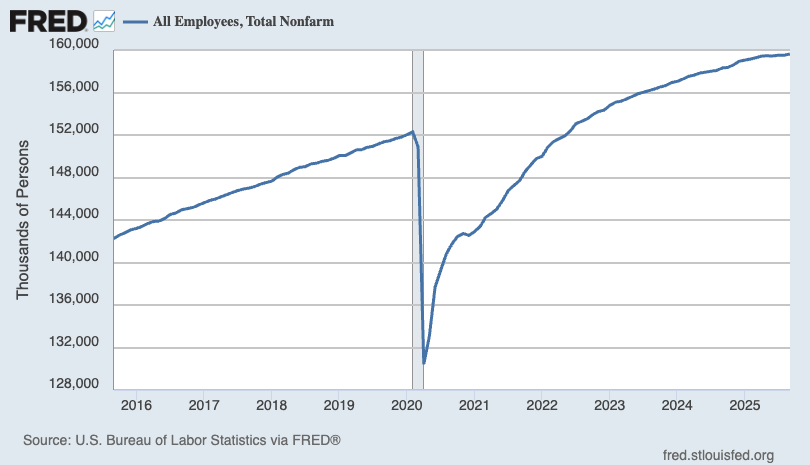
The unemployment rate — that is, the number of workers who identify as unemployed as a percentage of the civilian labor force — rose to 4.4% during the month. While the metric continues to hover near 50-year lows, it is now also at its highest level since October 2021.

While the major metrics continue to reflect modest job growth and low unemployment, the labor market isn’t as hot as it used to be.
For more on the labor market, read: We’re at an economic tipping point ⚖️ and 9 once-hot economic charts that cooled 📉
💸 Wage growth could be lower. Average hourly earnings rose by 0.27% month-over-month in September, down from the 0.33% pace in August. On a year-over-year basis, September’s wages were up 3.8%.

For more on why policymakers are watching wage growth, read: Revisiting the key chart to watch amid the Fed’s war on inflation 📈
🏭 Business investment activity improved in August. Orders for nondefense capital goods excluding aircraft — a.k.a. core capex or business investment — increased 0.4% to $76.5 billion in August.
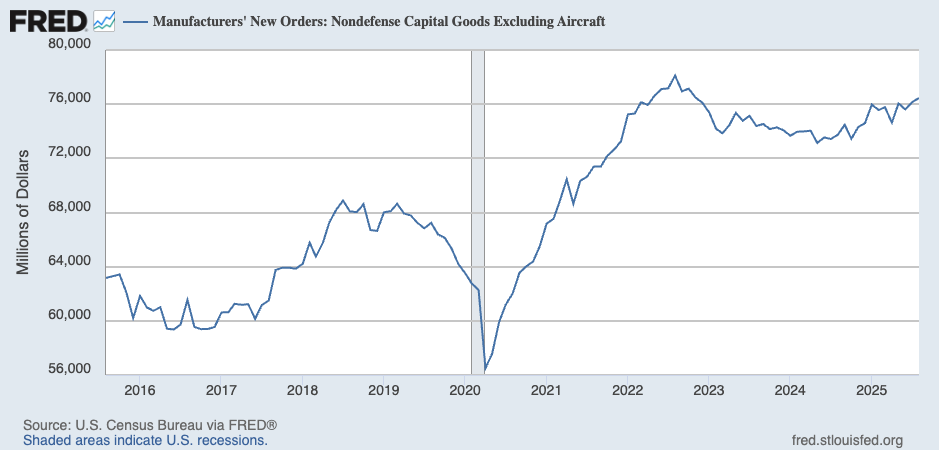
Core capex orders are a leading indicator, meaning they foretell economic activity down the road.
For more on deteriorating economic metrics, read: We’re at an economic tipping point ⚖️
🔨 Construction spending ticked lower. Construction spending increased 0.2% to an annual rate of $2.165 trillion in August.

📈 Near-term GDP growth estimates are tracking positively. The Atlanta Fed’s GDPNow model sees real GDP growth rising at a 4.2% rate in Q3.

For more on GDP and the economy, read: 9 once-hot economic charts that cooled 📉 and We’re at an economic tipping point ⚖️
Putting it all together 📋
🚨 The Trump administration’s pursuit of tariffs is disrupting global trade, with significant implications for the U.S. economy, corporate earnings, and the stock market. Furthermore, the absence of economic data from federal agencies due to the government shutdown has made it more challenging to read the economy. Until we get more clarity, here’s where things stand:
Earnings look bullish: The long-term outlook for the stock market remains favorable, bolstered by expectations for years of earnings growth. And earnings are the most important driver of stock prices.
Demand is positive: Demand for goods and services remains positive, supported by healthy consumer and business balance sheets. Job creation, although cooling, appears to be modestly positive, and the Federal Reserve — having resolved the inflation crisis — shifted its focus toward supporting the labor market.
But growth is cooling: While the economy remains healthy, growth has normalized from much hotter levels earlier in the cycle. The economy is less “coiled” these days as major tailwinds like excess job openings and core capex orders have faded. It has become harder to argue that growth is destiny.
Actions speak louder than words: We are in an odd period, given that the hard economic data decoupled from the soft sentiment-oriented data. Consumer and business sentiment has been relatively poor, even as tangible consumer and business activity continues to grow and trend at record levels. From an investor’s perspective, what matters is that the hard economic data continues to hold up.
Stocks are not the economy: There’s a case to be made that the U.S. stock market could outperform the U.S. economy in the near term, thanks largely to positive operating leverage. Since the pandemic, companies have aggressively adjusted their cost structures. This came with strategic layoffs and investment in new equipment, including hardware powered by AI. These moves are resulting in positive operating leverage, which means a modest amount of sales growth — in the cooling economy — is translating to robust earnings growth.
Mind the ever-present risks: Of course, we should not get complacent. There will always be risks to worry about, such as U.S. political uncertainty, geopolitical turmoil, energy price volatility, and cyber attacks. There are also the dreaded unknowns. Any of these risks can flare up and spark short-term volatility in the markets.
Investing is never a smooth ride: There’s also the harsh reality that economic recessions and bear markets are developments that all long-term investors should expect as they build wealth in the markets. Always keep your stock market seat belts fastened.
Think long-term: For now, there’s no reason to believe there’ll be a challenge that the economy and the markets won’t be able to overcome over time. The long game remains undefeated, and it’s a streak that long-term investors can expect to continue.
For more on how the macro story is evolving, check out the previous review of the macro crosscurrents. »
Key insights about the stock market 📈
Here’s a roundup of some of TKer’s most talked-about paid and free newsletters about the stock market. All of the headlines are hyperlinked to the archived pieces.
10 truths about the stock market 📈
The stock market can be an intimidating place: It’s real money on the line, there’s an overwhelming amount of information, and people have lost fortunes in it very quickly. But it’s also a place where thoughtful investors have long accumulated a lot of wealth. The primary difference between those two outlooks is related to misconceptions about the stock market that can lead people to make poor investment decisions.
The makeup of the S&P 500 is constantly changing 🔀
Passive investing is a concept usually associated with buying and holding a fund that tracks an index. And no passive investment strategy has attracted as much attention as buying an S&P 500 index fund. However, the S&P 500 — an index of 500 of the largest U.S. companies — is anything but a static set of 500 stocks.

The key driver of stock prices: Earnings💰
For investors, anything you can ever learn about a company matters only if it also tells you something about earnings. That’s because long-term moves in a stock can ultimately be explained by the underlying company’s earnings, expectations for earnings, and uncertainty about those expectations for earnings. Over time, the relationship between stock prices and earnings has a very tight statistical relationship.

Stomach-churning stock market sell-offs are normal🎢
Investors should always be mentally prepared for some big sell-offs in the stock market. It’s part of the deal when you invest in an asset class that is sensitive to the constant flow of good and bad news. Since 1950, the S&P 500 has seen an average annual max drawdown (i.e., the biggest intra-year sell-off) of 14%.
How the stock market performed around recessions 📉📈
Every recession in history was different. And the range of stock performance around them varied greatly. There are two things worth noting. First, recessions have always been accompanied by a significant drawdown in stock prices. Second, the stock market bottomed and inflected upward long before recessions ended.

In the stock market, time pays ⏳
Since 1928, the S&P 500 has generated a positive total return more than 89% of the time over all five-year periods. Those are pretty good odds. When you extend the timeframe to 20 years, you’ll see that there’s never been a period where the S&P 500 didn’t generate a positive return.

What a strong dollar means for stocks 👑
While a strong dollar may be great news for Americans vacationing abroad and U.S. businesses importing goods from overseas, it’s a headwind for multinational U.S.-based corporations doing business in non-U.S. markets.

Stanley Druckenmiller's No. 1 piece of advice for novice investors 🧐
…you don't want to buy them when earnings are great, because what are they doing when their earnings are great? They go out and expand capacity. Three or four years later, there's overcapacity and they're losing money. What about when they're losing money? Well, then they’ve stopped building capacity. So three or four years later, capacity will have shrunk and their profit margins will be way up. So, you always have to sort of imagine the world the way it's going to be in 18 to 24 months as opposed to now. If you buy it now, you're buying into every single fad every single moment. Whereas if you envision the future, you're trying to imagine how that might be reflected differently in security prices.
Peter Lynch made a remarkably prescient market observation in 1994 🎯
Some event will come out of left field, and the market will go down, or the market will go up. Volatility will occur. Markets will continue to have these ups and downs. … Basic corporate profits have grown about 8% a year historically. So, corporate profits double about every nine years. The stock market ought to double about every nine years… The next 500 points, the next 600 points — I don’t know which way they’ll go… They’ll double again in eight or nine years after that. Because profits go up 8% a year, and stocks will follow. That's all there is to it.
Warren Buffett's 'fourth law of motion' 📉
Long ago, Sir Isaac Newton gave us three laws of motion, which were the work of genius. But Sir Isaac’s talents didn’t extend to investing: He lost a bundle in the South Sea Bubble, explaining later, “I can calculate the movement of the stars, but not the madness of men.” If he had not been traumatized by this loss, Sir Isaac might well have gone on to discover the Fourth Law of Motion: For investors as a whole, returns decrease as motion increases.
Most pros can’t beat the market 🥊
According to S&P Dow Jones Indices (SPDJI), 65% of U.S. large-cap equity fund managers underperformed the S&P 500 in 2024. As you stretch the time horizon, the numbers get even more dismal. Over a three-year period, 85% underperformed. Over a 10-year period, 90% underperformed. And over a 20-year period, 92% underperformed. This 2023 performance follows 14 consecutive years in which the majority of fund managers in this category have lagged the index.
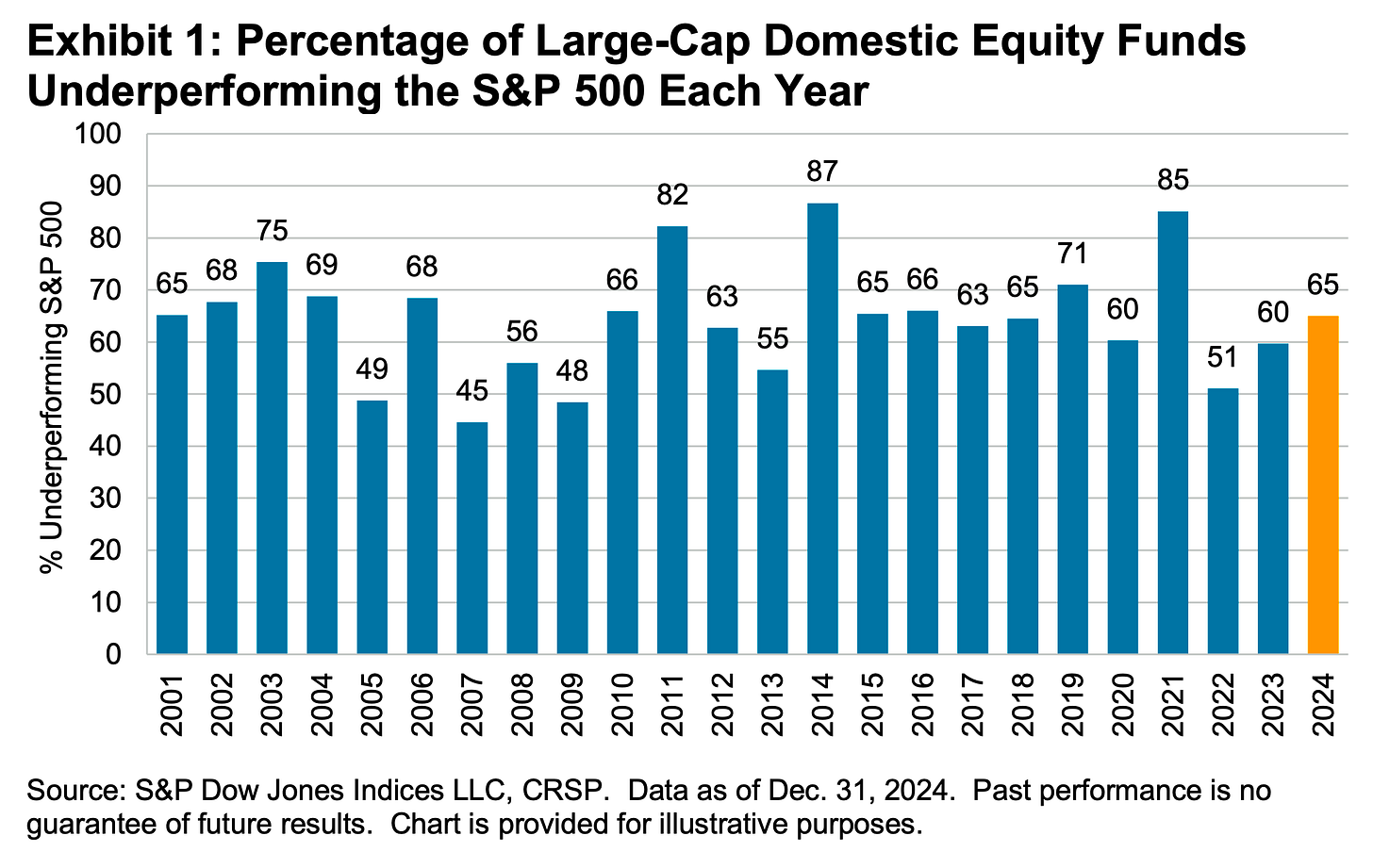
Proof that 'past performance is no guarantee of future results' 📊
Even if you are a fund manager who generated industry-leading returns in one year, history says it’s an almost insurmountable task to stay on top consistently in subsequent years. According to S&P Dow Jones Indices, just 4.21% of all U.S. equity funds in the top half of performance during the first year were able to remain in the top during the four subsequent years. Only 2.42% of U.S. large-cap funds remained in the top half
SPDJI’s report also considered fund performance relative to their benchmarks over the past three years. Of 738 U.S. large-cap equity funds tracked by SPDJI, 50.68% beat the S&P 500 in 2022. Just 5.08% beat the S&P in the two years ending 2023. And only 2.14% of the funds beat the index over the three years ending in 2024.

The odds are stacked against stock pickers 🎲
Picking stocks in an attempt to beat market averages is an incredibly challenging and sometimes money-losing effort. Most professional stock pickers aren’t able to do this consistently. One of the reasons for this is that most stocks don’t deliver above-average returns. According to S&P Dow Jones Indices, only 19% of the stocks in the S&P 500 outperformed the average stock’s return from 2001 to 2025. Over this period, the average return on an S&P 500 stock was 452%, while the median stock rose by just 59%.
